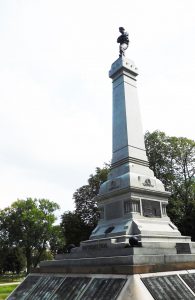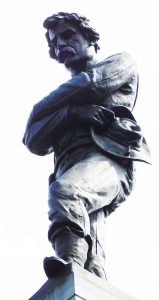An unlikely memorial in Chicago to soldiers from the Confederacy
By Jack McCarthy Chronicle Media — August 19, 2017
A small Confederate flag (above) flutters in a breeze at the base of a 40-foot monument at Chicago’s Oak Woods Cemetery. It marks the mass grave of more than 4,000 Southern soldiers who died while imprisoned at a camp in Chicago. (Photo by Jack McCarthy / Chronicle Media)
As controversial Confederate statues and symbols became the targets or removal efforts around the country last week, a solemn and largely forgotten tribute in Chicago to Civil War soldiers from the South remained undisturbed and mostly ignored.
Oak Woods Cemetery, located in the Greater Grand Crossing neighborhood on the city’s South Side, is the final resting place for as many as 6,000 Confederate prisoners of war who were held in Chicago during the Civil War.
A visitor to the 180-acre private cemetery last week found two tourists and a small Confederate flag fluttering in a hot summer breeze at the base of a 40-foot tall memorial, the centerpiece of a two-acre grassy area containing the mass grave of remains.
“I didn’t even know this was here,” said one man, who was visiting the nearby Hyde Park neighborhood before coming to Oak Woods. “It’s hard to find.”
Atop the Confederate Mound memorial is a bronze figure of a soldier with arms crossed, hat in hand and head bowed in sorrow.
A series of plaques added around 1910-11 are mounted on four sides of the base contain the names of the 4,342 Confederate soldiers known to be buried there.
 One side contains the words “Confederate Dead” in large raised letters while three bas-relief bronze panels at the base depict “The Call to Arms” on the east side, “A Veteran’s Return Home” on the west side and “A Soldier’s Death Dream” on the south side.
One side contains the words “Confederate Dead” in large raised letters while three bas-relief bronze panels at the base depict “The Call to Arms” on the east side, “A Veteran’s Return Home” on the west side and “A Soldier’s Death Dream” on the south side.
Four cannons and mounds of cannonballs surround the monument.

A closeup of a bronze figure at the top of the monument, head bowed in sorrow. (Photo by Jack McCarthy / Chronicle Media)
New efforts to remove Confederate statues and symbols arose around the country last week following violent clashes during a march by white nationalists protesting the removal of a statue or Gen. Robert E. Lee in Charlottesville, Va. A counter protester was killed and other were injured in the disturbances.
In Durham, N.C., a statue of a Confederate soldier was toppled by individuals during a protest gathering while four Confederate memorials were removed by officials in Baltimore in the dead of night.
CNN, meanwhile, reported last week that several cities across the South were considering removing Confederate memorials.
President Donald Trump weighed in to oppose the removals.
“Sad to see the history and culture of our great country being ripped apart with the removal of our beautiful statues and monuments,” Trump said in a tweet.
Oak Woods Cemetery, located on East 67th St. near Cottage Grove Ave., was established in 1854. Today it is a serene site with tall trees, aging monuments and mausoleums and graves of both prominent and regular Chicagoans.
It is the final resting place for Chicago mayors from William Hale Thompson to Harold Washington, the city’s first African-American chief executive. Also buried here is baseball commissioner Kenesaw Mountain Landis, Olympian Jesse Owens, physicist Enrico Fermi and civil rights advocate Ida B. Wells.
The Confederate memorial is located in cemetery’s southwest area, with soldiers buried in concentric circles around the monument. Most of them were held in Camp Douglas, located five miles north in the current Bronzeville neighborhood, where many died of cholera and smallpox.
Oak Woods is actually the second grave site for the soldiers. They were originally buried on the grounds of the nearby prison camp or at Chicago City Cemetery, located in what is now Lincoln Park.
Repeated flooding in Lincoln Park forced the cemetery’s closure and the remains were moved to Oak Woods between 1865 and 1867. The monument was dedicated by President Grover Cleveland in 1895.
Free subscription to the digital edition of the Cook County Chronicle
Read the current issue of the Cook County Chronicle
—- An unlikely memorial in Chicago to soldiers from the South —



